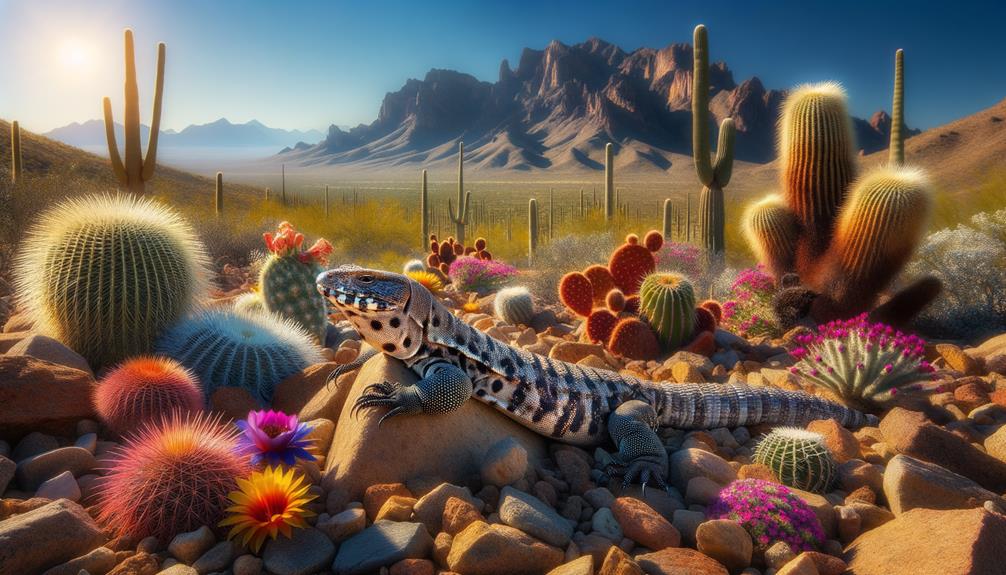I've had the opportunity to study the remarkable adaptations of Saharan reptiles, which have evolved to survive in one of the harshest environments on Earth. To cope with extreme heat, these reptiles have developed behaviors such as shifting their activity patterns seasonally and basking selectively. When it comes to hydration, they've developed efficient kidneys and reduced water loss through their skin. Geological events, like the breakup of the Arabian plate and the formation of the Red Sea, have played a pivotal role in shaping their evolution. For instance, the Stenodactylus genus has developed fringed toes, perfectly suited for walking on sand. These reptiles also exhibit high genetic variability, demonstrating a dynamic response to the harsh Saharan conditions. There's still much to uncover about their remarkable survival strategies.
Key Takeaways
Saharan reptiles have adapted to their harsh environment in various ways. At night, they're active to avoid the scorching daytime heat and conserve energy. To cope with the arid conditions, they have efficient kidneys that concentrate their urine, minimizing water loss. Their fringed toes enable them to move effectively in the loose, sandy terrain. To regulate their body temperature in extreme climates, they employ behavioral adaptations like selective basking and burrow use. During brief summer rains, they experience rapid growth and development, which helps maximize their reproductive success.
Geological Influences
The geological forces that reshaped North Africa and Arabia, particularly the break-up of the Arabian plate from Africa and the formation of the Red Sea around 30 million years ago, have had a profound impact on the evolution of Saharan reptiles. This geological evolution set the stage for the unique biogeographical landscape we see today. The Sahara Desert, a harsh and expansive environment, is a direct result of these ancient tectonic movements.
During the late Miocene, approximately 11 to 5 million years ago, the establishment of the Gomphotherium land bridge connected Afro-Arabia with Eurasia. This bridge facilitated species migrations, greatly impacting the diversity and distribution of reptiles in North Africa. For example, the Stenodactylus genus, a group of geckos, showcases evolutionary patterns closely tied to these geological events.
The opening of the Red Sea not only isolated populations but also created new habitats, driving speciation. Phylogenetic analyses reveal that divergence times within the Stenodactylus genus correlate with these major geological shifts, underscoring the profound impact of the region's geological evolution. This ancient dance of tectonic plates and land bridges crafted the incredible diversity of reptilian life in the Sahara Desert we observe today.
Climatic Impacts
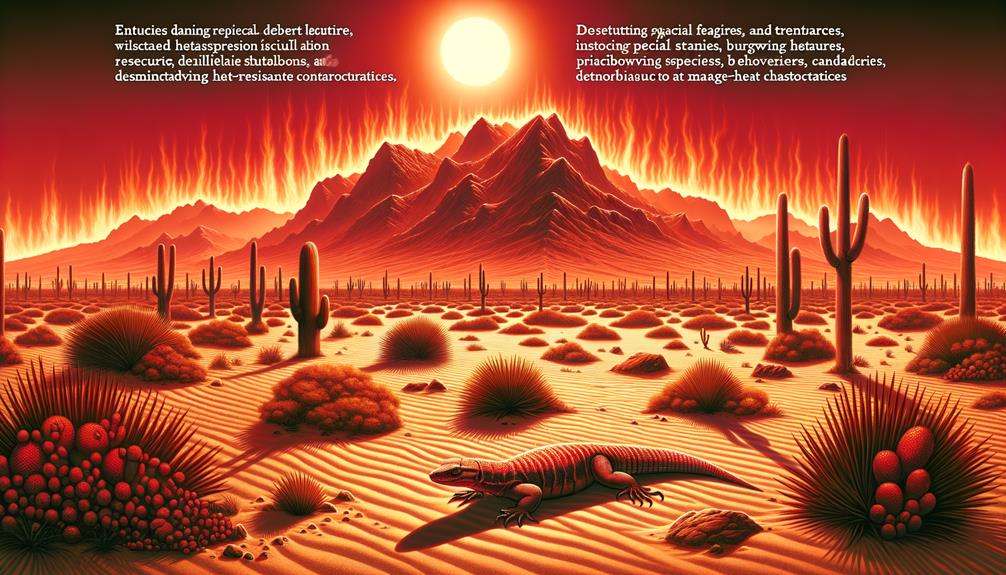
When considering how Saharan reptiles cope with extreme climatic conditions, I'm drawn to their remarkable strategies for regulating temperature, conserving water, and surviving in the desert. These adaptations are not only fascinating but also crucial for life in one of the harshest environments on Earth. Let's delve into how these reptiles thrive despite the scorching heat and scarce water.
Temperature Regulation Tactics
Desert reptiles have evolved fascinating adaptations to regulate their body temperature, employing a range of strategies to survive in the harsh Sahara environment.
To cope with the extreme heat and scarce water, these creatures have developed clever tactics to maintain their body temperature within survivable limits.
One approach is to change their activity patterns seasonally, becoming more active at night during the hottest months to conserve energy and avoid the scorching daytime heat.
Some reptiles also practice selective basking, soaking up the morning sun before retreating to shaded areas during the peak temperature hours to maintain a stable body temperature.
Others, like the desert iguana, spend extended periods in burrows where the temperature is more moderate, reducing their need for water and conserving energy.
Some reptiles can even tolerate body temperatures up to 108°F, a remarkable physiological adaptation that enables them to thrive in the intense desert heat.
These temperature regulation tactics are crucial for survival in the Sahara's harsh environment. By employing a combination of behavioral and physiological strategies, desert reptiles effectively navigate the challenges posed by their extreme habitat.
Limited Water Adaptations
In the harsh Sahara Desert, reptiles have developed remarkable adaptations to conserve water. To survive in this unforgiving environment, animals like the Rueppell's and fennec foxes have evolved genetic traits that enable them to make the most of the little water available.
Similarly, reptiles have also developed remarkable adaptations. For instance, the New Mexico spadefoot toad, which lives in the desert, has a smaller genome size, allowing it to grow and develop rapidly during the brief summer rains. This adaptation ensures that it can take advantage of the fleeting water supply before the desert dries up again.
These species have also developed convergent evolution, which enables them to tolerate dehydration, starvation, and extreme temperatures, making them resilient in the harsh Sahara environment. The genetic traits found in these species are a testament to their adaptability and ability to thrive in extreme conditions.
In essence, the desert animals that have adapted to live in the Sahara illustrate how life can flourish even in the most inhospitable environments, inspiring a sense of resilience and perseverance.
Desert Survival Strategies
Understanding the intricate survival strategies of Saharan reptiles provides valuable insights into how these creatures thrive in the harsh desert climate. By studying these resilient desert dwellers, I've identified several key adaptations that ensure their survival in such unforgiving conditions.
- Temperature Regulation: Saharan reptiles employ various strategies to regulate their body temperature, such as altering their activity patterns with the seasons and utilizing specialized physiological mechanisms to maintain stable body temperatures.
- Water Conservation: Like desert-dwelling foxes, these reptiles have evolved to minimize water loss, a critical trait in the arid Saharan environment. They achieve this through efficient kidneys, concentrated urine, and reduced water loss through their skin.
- Adapted Reproduction: Some desert amphibians have remarkable adaptations, such as accelerated reproduction rates, specialized burrowing structures, and the ability to remain in larval form, synchronizing their life cycles with sporadic summer rains.
- Genetic Efficiency: Desert reptiles have developed genetic variations that enhance their tolerance to starvation and dehydration, similar to the New Mexico spadefoot toad's smaller genome size, which allows for faster development.
These adaptations highlight the remarkable resilience and ingenuity of living organisms in the desert, offering profound insights into biological survival strategies under extreme climatic conditions.
Phylogenetic Insights
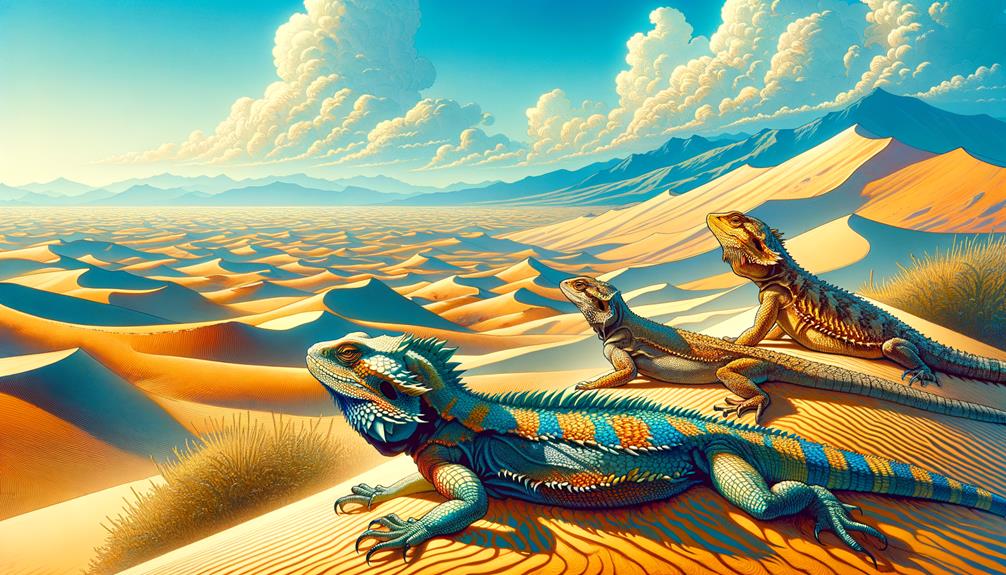
Analyzing the phylogenetic relationships within the genus Stenodactylus reveals intriguing insights into how geological and climatic events have shaped the diversification of these resilient geckos. Found mainly in North Africa and Arabia, the genus is divided into three major groups, reflecting their evolutionary journey through millions of years of Saharan climates.
The phylogenetic analysis suggests that the divergence of these groups coincides with significant geological events, such as the opening of the Red Sea around 30 million years ago. This grand-scale tectonic shift likely isolated populations, paving the way for speciation. The fluctuating environments during the Miocene epoch further drove the diversification of Stenodactylus species as they adapted to their changing surroundings.
High genetic variability within some species hints at a rich evolutionary history, with potential undiscovered species waiting to be described. This genetic diversity underscores the need for a thorough taxonomic revision, particularly for the Stenodactylus petrii – Stenodactylus stenurus complex. By understanding these phylogenetic insights, we can appreciate the intricate interplay between geology, climate, and the relentless drive of life to adapt and thrive in the harsh Saharan environment.
Stenodactylus Diversification
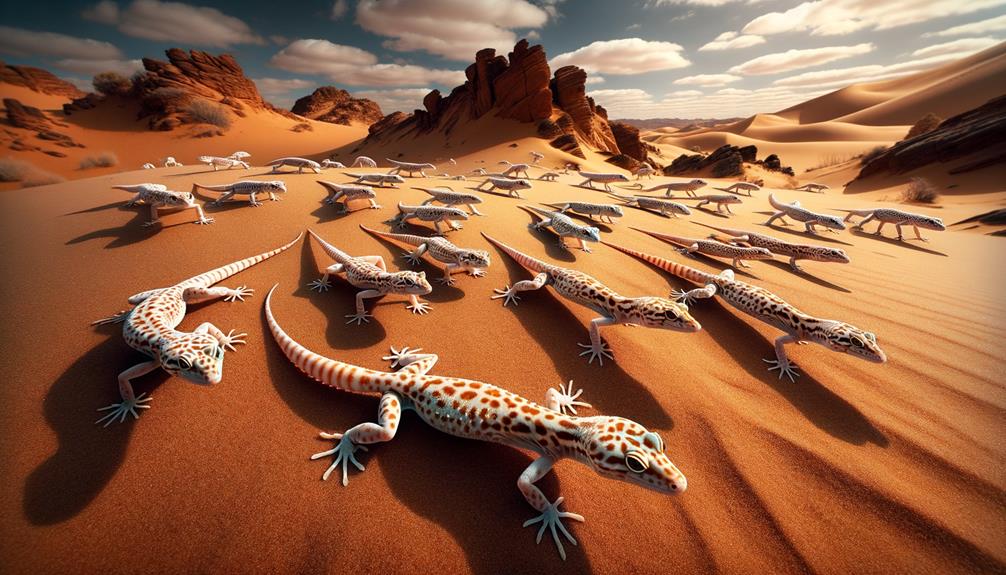
When exploring the diversification of Stenodactylus, it's striking to see how their specialized habitats and adaptive physical features have enabled them to flourish in the harsh Saharan environment. These geckos have developed unique traits, such as fringed toes for navigating loose sand and nocturnal habits to avoid the scorching daytime heat. By examining these adaptations, we gain insight into how Stenodactylus species have successfully spread across arid regions.
Habitat Specialization Traits
In the harsh arid and hyper-arid environments of North Africa and Arabia, Stenodactylus species have evolved remarkable adaptations to thrive in these inhospitable regions. Similar to their counterparts in the deserts of North America, such as the fennec fox, they have developed unique traits to survive and flourish.
Four key habitat specialization traits of Stenodactylus include:
- Burrowing Behavior: They create intricate networks of tunnels and burrows to escape extreme temperatures and predators.
- By being active at night, they avoid the scorching daytime heat, a strategy known as Nocturnal Activity.
- Water Conservation is crucial, and they have developed the ability to extract moisture from their food and minimize water loss.
- Their Camouflage allows them to blend seamlessly with the sandy environment, making it difficult for predators to spot them.
These traits demonstrate the remarkable adaptability of Stenodactylus species. Like desert plants that have evolved to conserve water, these reptiles have perfected their strategies to survive and thrive in harsh conditions. This remarkable specialization is a testament to nature's ingenuity and the drive for survival in extreme environments.
Adaptive Physical Features
Stenodactylus species have developed remarkable adaptive physical features that enable them to thrive in the harsh Saharan desert environment. These reptiles live in a region characterized by vast desert sands and extreme aridity. To survive in such dry conditions, they have evolved several key adaptations.
Their elongated limbs and specialized toe pads allow them to move quickly and efficiently over loose sand, minimizing energy expenditure and avoiding scorching surface temperatures. Their cryptic coloration provides effective camouflage, blending seamlessly with the desert sands to evade predators and ambush prey.
Moreover, Stenodactylus species have developed remarkable physiological adaptations to manage water scarcity. They can endure long periods without direct water intake, relying on metabolic water produced from food and minimizing water loss through highly efficient kidneys and skin.
The Miocene climatic instability played a significant role in their diversification, driving the evolution of these adaptive traits. Phylogenetic analyses reveal significant genetic variability within the genus, underscoring the complex evolutionary history shaped by geological events like the opening of the Red Sea. These findings highlight the remarkable adaptability of Stenodactylus species in one of the harshest environments on Earth.
Adaptive Traits
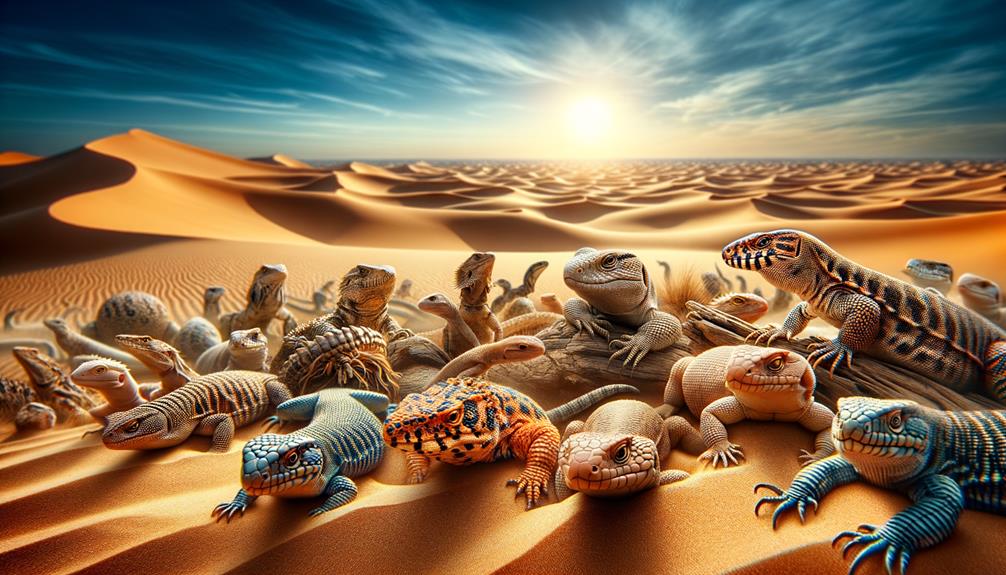
Mastering survival in the Sahara, reptiles have developed remarkable adaptations to thrive in the harsh desert environment. These adaptations include efficient water conservation, advanced thermoregulation, and specialized locomotion techniques that guarantee their survival in the largest desert on earth.
Water conservation is crucial in the Sahara. Many reptiles, like desert iguanas, have developed unique mechanisms to conserve water. They have lateral lymph sacs that store fluid and can reabsorb water from their waste. Additionally, they have large urinary bladders that can store up to 40% of their body weight in water. This adaptation allows them to survive in areas where resources are scarce.
Desert reptiles have also developed fascinating thermoregulation strategies. Unlike Fennec foxes, which produce heat to stay warm, reptiles adapt to the Sahara's extreme temperatures by changing their activity patterns with the seasons. They also use passive heat exchange to avoid overheating and can tolerate high body temperatures, such as the desert iguana's range of 100-108°F.
Specialized locomotion techniques, like the sidewinding gait of horned vipers, enable these reptiles to navigate loose, sandy substrates efficiently. Moreover, their camouflage patterns and ability to burrow into the sand further enhance their survival, allowing them to escape the scorching heat of the desert environment.
Future Research

Future research on Saharan reptile adaptations holds immense potential for uncovering the genetic and molecular secrets behind their extraordinary survival mechanisms in one of the planet's most unforgiving environments. By sequencing the genomes of several species endemic to the North African desert, scientists can identify the genetic basis for their remarkable resilience. For instance, examining how specific genes influence thermoregulation and water conservation can provide valuable insights into their ability to thrive in extreme heat.
Phylogenetic analysis can also help us understand how closely related these desert dwellers are to their non-desert counterparts. Comparative studies between these groups will shed light on the evolutionary drivers behind their convergent adaptations. For example, differences in body weight and physiological traits can reveal how these reptiles have uniquely adapted to their harsh surroundings.
Long-term monitoring of Saharan reptile populations is crucial, particularly in the context of climate change and habitat loss. Understanding their responses to these environmental pressures will inform conservation strategies. Integrating traditional ecological knowledge from indigenous communities can complement scientific findings, enriching our understanding and promoting sustainable management of these fragile ecosystems.
Frequently Asked Questions
What Are Some Adaptations in the Sahara Desert?
Some desert mammals can survive with as little as 10% water loss, which is fascinating. Their genetic adaptations for energy conservation, thermogenesis, and efficient water homeostasis enable them to thrive in the extreme Sahara conditions.
What Are Two Ways in Which Most People Have Adapted to Living in the Sahara Desert?
Most people living in the Sahara Desert have adapted to the harsh environment in two main ways. Firstly, they wear loose, light-colored clothing that reflects sunlight and helps conserve water. Additionally, they use traditional knowledge to locate and store water, ensuring their survival in this unforgiving environment.
What Are Some Adaptations of Reptiles?
Reptiles have developed unique adaptations to survive in harsh environments. For instance, many are active at night and burrow underground to escape extreme temperatures. They've also evolved specialized traits to regulate their body temperature, conserve water, and move efficiently in their habitats. These traits include large ears for heat dissipation, specialized urinary bladders for water conservation, and counter-sunk jaws that enable them to navigate sandy terrain with ease.
What Are 3 Adaptations in the Desert?
In the desert, reptiles have developed three key adaptations to survive the harsh environment. One strategy is burrowing underground to escape the scorching heat. Another tactic is being nocturnal, meaning they're most active at night to avoid the blistering daytime temperatures. Finally, their specialized scales help minimize water loss, ensuring they conserve this precious resource. These adaptations are crucial for their survival in such a hostile environment.


